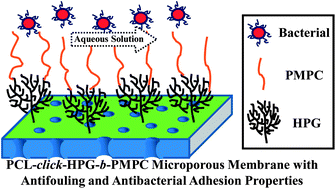Surface-functionalizable membranes of polycaprolactone-click-hyperbranched polyglycerol copolymers from combined atom transfer radical polymerization, ring-opening polymerization and click chemistry
Abstract
Hyperbranched polyglycerols containing terminal alkyne and alkyl bromide groups (CH![[triple bond, length as m-dash]](https://www.rsc.org/images/entities/char_e002.gif) C-HPG-Br) were first synthesized via propargyl alcohol-initiated ring-opening polymerization (ROP) of glycidol, followed by reaction of 2-bromoisobutyryl bromide (BIBB) with the hydroxyl groups to introduce the atom transfer radical polymerization (ATRP) initiators on HPG. Hydrophobic azido-terminated poly(ε-caprolactone) (PCL-N3), prepared a priori via 2-azidoethanol-initiated ROP of ε-caprolactone, was then coupled to the CH
C-HPG-Br) were first synthesized via propargyl alcohol-initiated ring-opening polymerization (ROP) of glycidol, followed by reaction of 2-bromoisobutyryl bromide (BIBB) with the hydroxyl groups to introduce the atom transfer radical polymerization (ATRP) initiators on HPG. Hydrophobic azido-terminated poly(ε-caprolactone) (PCL-N3), prepared a priori via 2-azidoethanol-initiated ROP of ε-caprolactone, was then coupled to the CH![[triple bond, length as m-dash]](https://www.rsc.org/images/entities/char_e002.gif) C-HPG-Br polymer through a Cu(I)-catalyzed alkyne–azide click reaction. The resultant linear-hyperbranched PCL-click-HPG copolymers were cast by phase inversion in an aqueous medium into microporous membranes of well-defined and uniform pores. Not only could the HPG contents in the PCL-click-HPG copolymers be used to control the pore size and porosity of the resulting membranes, but also the alkyl halide chain-ends of HPG allowed the subsequent functionalization of membrane and pore surfaces. The PCL-click-HPG-b-PMPC membrane was prepared via surface-initiated ATRP of zwitterionic 2-methacryloyloxyethyl phosphorylcholine (MPC) from the PCL-click-HPG membrane and pore surfaces. The PCL-click-HPG-b-PMPC membranes exhibit good antifouling and antibacterial adhesion properties with negligible cytotoxicity effects, making the membranes potentially useful for biomaterials and biomedical applications.
C-HPG-Br polymer through a Cu(I)-catalyzed alkyne–azide click reaction. The resultant linear-hyperbranched PCL-click-HPG copolymers were cast by phase inversion in an aqueous medium into microporous membranes of well-defined and uniform pores. Not only could the HPG contents in the PCL-click-HPG copolymers be used to control the pore size and porosity of the resulting membranes, but also the alkyl halide chain-ends of HPG allowed the subsequent functionalization of membrane and pore surfaces. The PCL-click-HPG-b-PMPC membrane was prepared via surface-initiated ATRP of zwitterionic 2-methacryloyloxyethyl phosphorylcholine (MPC) from the PCL-click-HPG membrane and pore surfaces. The PCL-click-HPG-b-PMPC membranes exhibit good antifouling and antibacterial adhesion properties with negligible cytotoxicity effects, making the membranes potentially useful for biomaterials and biomedical applications.


 Please wait while we load your content...
Please wait while we load your content...